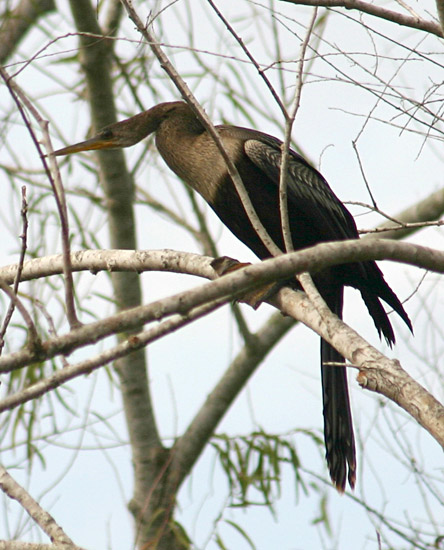Nomdeploom (talk | contribs) m (Add a link to the IBC videos + minor text changes and distribution addiitons) |
Nomdeploom (talk | contribs) m (Add an external link) |
||
| Line 19: | Line 19: | ||
==External Links== | ==External Links== | ||
| − | [http://ibc.hbw.com/ibc/phtml/especie.phtml?idEspecie=271 Anhinga videos] on the Internet Bird Collection | + | *[http://www.mbr-pwrc.usgs.gov/id/framlst/i1180id.html Anhinga] USGS Patuxent Wildlife Research Center |
| + | *[http://ibc.hbw.com/ibc/phtml/especie.phtml?idEspecie=271 Anhinga videos] on the Internet Bird Collection | ||
{{GSearch|Anhinga+anhinga}} | {{GSearch|Anhinga+anhinga}} | ||
[[Category:Birds]] | [[Category:Birds]] | ||
Revision as of 16:23, 26 October 2007
- Anhinga anhinga
Identification
A large (89cm body, 117cm wingspan) slender waterbird with dark body and very long tail and neck. The male is jet black with green iridescence, and has dramatic silver and white markings on the upper back and forewings. Long yellow sharp bill, red eyes with blue skin surround.
Distribution
All along the Gulf of Mexico coast, inland east Texas to Florida, and along a narrow strip on southwest coast of mainland Mexico. Central and South America (unknown, needs work)
Taxonomy
Kingdom: Animalia-> Phylum: Chordata-> Class: Aves -> Order: Pelecaniformes -> Family: Anhingidae-> Genus: Anhinga-> Species: A. anhinga
Habitat
Freshwater ponds, lakes, and marshes.
Behaviour
Dives frequently for fish, which it spears with its long sharp bill, then tosses them in the air until it can swallow them headfirst. The colloquial name, Snakebird, can be quite descriptive when this bird is in the water - it swims with its body mostly submerged, and just the long sinuous neck above. On quick glance, it can thus appear to be a swimming snake. The other common posture is on a tree near or over water, where it spends hours with wings extended, drying in the sun; unlike ducks, it has no oil with which to waterproof its feathers, an adaptation to improve its diving ability. Monogamous.
External Links
- Anhinga USGS Patuxent Wildlife Research Center
- Anhinga videos on the Internet Bird Collection





